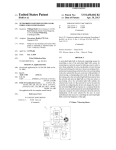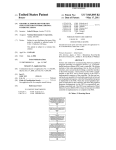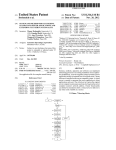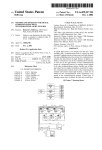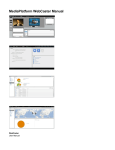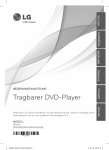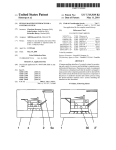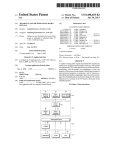Download Web content management based on timeliness metadata
Transcript
US008365069B1 (12) Ulllted States Patent (10) Patent N0.: Haubrich et a]. (54) US 8,365,069 B1 (45) Date of Patent: WEB CONTENT MANAGEMENT BASED ON 7,561,159 B2 * TIMELINESS METADATA 2002/0087986 A1 * 2004/0001106 A1 * . . 2007/0139418 A1 * (75) Inventors: Manfred Haubrlch, Genslngen (DE); 2007/0277 102 A1 51111011 Lorenz, Gelsenhelm (DE); 2009/0077173 A1 Frank Marschollek, ldar-Oberstein (DE); Rainer wolafkas Jan. 29, 2013 7/2009 Abel et a1. .................. .. 345/473 7/2002 Markel .......... 1/2004 Deutscher et al 6/2007 Abel et al. . . . .. 725/42 345/838 .................. .. 345/474 11/2007 Kanzaki 3/2009 Lowery et al. FOREIGN PATENT DOCUMENTS Holheim-Langenhain (DE); Alexander W0 WO 01/57729 A1 Wolf-Reber, Dretzenbach (DE) 8/2001 OTHER PUBLICATIONS (73) Assignee: lnternatiqnal Business Machines Corporatlon, Armonk, NY (Us) Ektron, Inc.; Ektron CMS400.Net User Manual; Version 7.0, Revi sion 4; May 2007; Nashua, NH. (*) Adobe Systems Inc.; Using Adobe Contribute CS5; Oct. 22, 2010; San Jose, CA, Notice: Subject to any disclaimer, the term of this patent is extended or adjusted under 35 U.S.C. 154(b) by 0 days. (21) APP1~ N05 13/211,654 (22) Filed: * cited by examiner Primary Examiner * Maikhanh Nguyen Aug- 17’ 2011 (74) ‘Attorney, Agent, or Fzrm * Dav1d M1ms; Robert C. Rolnrk (51) Int. Cl. G06F 17/00 (2006.01) (57) ABSTRACT (52) G06F 15/16 (200601) US. Cl. ...... .. 715/234; 715/201; 715/205; 715/717; A server receives a hypertext request from a client. The server looks up a hypertext document’ wherein looking up Com_ 709/203; 709/219; 709/224 prises obtaining a ?rst HTML element and a second HTML (58) Field of Classi?cation Search ................ .. 715/201, element and Combining the ?rst HTML element and second 715/202, 204, 205, 209, 210, 226, 231, 234, 715/255, 273, 700, 714, 717, 760; 709/ 201*204, HTML element into a hypertext document, in response receiving the hypertext request from the client. The server _ _ 709/215, 217*21, 220, 22s, 226, 227 See aPPhCaUOn ?le for Complete Search hlstol'y- parses the hypertext document for timeliness tags. The server generates at least one header tag based on the timeliness tags. _ (5 6) The server determines Whether at least one expired tag is References Clted among the timeliness tags. Responsive to a determination that at least one expired tag is among the timeliness tags, the US. PATENT DOCUMENTS 6,173,317 B1* server can look up a timeliness tag rule corresponding to the at least one timeliness tag. 1/2001 Chaddha et al. . 6,760,043 B2 * 7/2004 6,886,005 B2 7,325,193 B2 4/2005 Davis 1/2008 Edd et al. Markel .......... .. 7 Claims, 5 Drawing Sheets SERVER RECEIVES HTTP REQUEST SERVER PARSES HTML ELEMENTS OF THE HTML TIMELINESS TAGS SERVER GENERATES HEADER TAGS BASED ON 417 TIMELINESS TAGS "I ' SERVER CONFIGURED TO HANDLE EXPIRAP 00m ES 431 42 STRICT TIMELINESS HANDLING ENABLED? REWRITE HTML DATA ACCORDING TO A TIMELINESS TAG RULE YES 42 SEND HTTP ERRDR T0 SEND HTI'P RESPONSE TO CLIENT WITH NEWHEADER CLIENT SEND HTTP RESPONSE TO CLIENT US. Patent Jan. 29, 2013 Sheet 1 of5 US 8,365,069 B1 FIG. I 100 (—106 / PROCESSOR (-110 I <—102 GRAPHICS (-108 ‘_ 11s MAIN PROCESSOR 4-’ NB/MCH 4-’ MEMORY AUDIO ADAPTER r136 SIO I r104 140 BUS HARD DISK 13s - SB/ICH 1 BUSY l USB AND CD ROM OTHER DR|vE PORTS L126 L130 L132 NETWORK ADAPTER L112 1 l 1> KEYBOARD Egg; L134 AND MOUSE ADAPTER L 12° MODEM ‘L122 ROM L124 US. Patent Jan. 29, 2013 Sheet 2 of5 US 8,365,069 B1 FIG. 2 20 2311 WEB BROWSER h PLUG-IN m CLIENT a SEARCH ENG'NE II 2507 2517 WEB SERVER PROCESSING ‘ ENGINE 2537_ WEBSERVER ‘ ' 24 261 MODULE f M a! \ INTERNET / WEB SERVER (263 _ O O. CONFIGURA DATABASE WEB SERVER TION FILE 1‘ \d/ 2541 v METADATA REGISTRY 26 311 301 | . ,, . ,, 313 I ‘1 Fig- 4/ 3A . I .1 .. TI <|mg src= pathlplcbmp create-date=“2011-01-03" exp|re-date= 2012-12-31 /> 328 “ \ 3211 _ r <META NAME=“earI|est-create-date” CONTENT=“2011-01-03” I> 3231 <META NAME=“Iatest-expire-date” CONTENT=“2014-01-03” > [300 "* [ Fig 35 <*\ I355 UID @ OWNER E “create-date" E “expire-date" @ 2011-12-20 2011-12-25 1234 I 5678 9012 LAST UPDATE I US. Patent Jan. 29, 2013 Sheet 3 of5 US 8,365,069 B1 FIG. 4 ( BEGIN I 4111 SERVER RECEIVES HTTP REQUEST SERVER PARSES HTML 4151 ELEMENTS OF THE HTML DOCUMENT FOR TIMELINESS TAGS II SERVER GENERATES 4171 HEADER TAGS BASED ON TIMELINESS TAGS 41 NO SERVER CONFIGURED TO HANDLE EXPIRA TION? NO 421 EXPIRED TAG FOUND? 4311 SEND HTTP RESPONSE TO NO 423 STRICT TIMELINESS HANDLING ENABLED? REWRITE HTML DATA 427-» ACCORDING TM TIMELINESS TAG RULE + 4291 _ SEND HTTP RESPONSE TO ' CLIENT WITH NEW HEADER 425 ‘1 SEND HTTP ERROR TO CLIENT L ' _ ' US. Patent Jan. 29, 2013 Sheet 4 of5 US 8,365,069 B1 FIG. 5 5011 SEND HTTP REQUESTTO URL W 5031 RECEIVE WEB SERVER RESPONSE 505 WEB PAGE EXPIRED? YES HTML ELEMENTS 5071 ANALYZE OF THE WEB PAGE FOR TIMELINESS TAGS 509 FOUND A TIMELINESS TAG? REFERENCES TO METADATA IN REGISTRY? V 5191 REQUEST TIMELINESS 5151" 5137 DATA FROM METADATA REGISTRY HANDLE TIMELINESS TAGS AS CONFIGURED BY RULES 5171i DISPLAY WEB PAGE TO D USER ‘ 7 END RENDER HTTP RESPONSE TO USER US 8,365,069 B1 1 2 WEB CONTENT MANAGEMENT BASED ON TIMELINESS METADATA one expired tag is among the timeliness tags, the server can look up a timeliness tag rule corresponding to the at least one timeliness tag. BACKGROUND BRIEF DESCRIPTION OF THE SEVERAL VIEWS OF THE DRAWINGS The present invention relates generally to a data processing system and computer program product for sorting informa tion, and more speci?cally, to searching hypertext documents and selectively transmitting and/ or displaying a document FIG. 1 is a block diagram of a data processing system in accordance With an illustrative embodiment of the invention; FIG. 2 is a block diagram of a netWork architecture in accordance With an illustrative embodiment of the invention; and/ or its component parts. Metadata is data about data, or more speci?cally, data concerning the content of data. Metadata can include the source of data, the type of data, and dates related to data. For example, a granted patent has at least tWo associated meta FIG. 3A is starting strings for timeliness tags in accordance With an illustrative embodiment of the invention; FIG. 3B is a table or data structure of the related informa tion applicable to a HyperText Markup Language element (HTML element) in accordance With an illustrative embodi data. First, the granted patent has a ?ling date that identi?es When the data Was submitted as a patent application to the ment of the invention; US. Patent and Trademark O?ice. Second, the granted patent has a granted date, Which is the date on Which the patent o?ice granted the patent in a Way that permits the oWner to enforce his rights to the material described therein. Metadata plays a key role in the Internet. Speci?cally, as FIG. 4 is a ?owchart of methods and/or processes per formed at a server machine in accordance With an illustrative 20 FIG. 5 is a ?owchart of methods and/or processes per formed at a client machine in accordance With an illustrative used in markup languages such as hypertext markup language (HTML), metadata can be placed in documents in a manner that is not ordinarily visible to a user of a modern broWser. This metadata is enclosed in one or more HTML tags. The ?rst HTML pages Were authored by people in a Way Where embodiment of the invention; embodiment of the invention; and FIG. 6 is an example of registry references in accordance 25 With an illustrative embodiment of the invention. DETAILED DESCRIPTION each keystroke is typically added by a human being. HoW ever, as neW models for blending articles With advertising and navigation evolved, pages began to appear based on frag 30 ments or elements that Were authored independent of one ment may be implemented. Data processing system 100 is an example of a computer, in Which code or instructions imple menting the processes of the present invention may be from the other. Search engines are a combination of databases that are fed by information collected by spiders. Spiders are automated programs that collect HTML by methodically traversing the With reference noW to the ?gures and in particular With reference to FIG. 1, a block diagram of a data processing system is shoWn in Which aspects of an illustrative embodi 35 located. In the depicted example, data processing system 100 links in each page. Spiders can obtain metadata based on the date that the spider visited an HTML page, for example, as employs a hub architecture including a north bridge and memory controller hub (NB/MCH) 102 and a south bridge de?ned by its universal resource locator (URL). Such infor and input/output (I/O) controller hub (SB/ICH) 104. Proces mation can be used later to ?lter results of a search engine query to a speci?ed range of datesiWhere the dates are those dates that the spider collected the data. One limitation of the above method of creating ‘date’ meta data is that the search engine only identi?es the date on Which the spider visited the Web page. Nothing indicates the creation date. Conventional Web pages’ HTML tags also do not iden tify an expiration date, nor other metadata concerning When 40 processor 110 may connect to the NB/MCH through an accel erated graphics port (AGP), for example. In the depicted example, local area netWork (LAN) adapter 112 connects to south bridge and I/O controller hub 104 and 45 the Web page, or its component elements, is obsolete or oth erWise invalid. In addition, the component parts themselves may have distinct creation dates, Which the prior art fails to identify in HTML tags. Accordingly, a remedy is sought. sor 106, main memory 108, and graphics processor 110 con nect to north bridge and memory controller hub 102. Graphics 50 audio adapter 116, keyboard and mouse adapter 120, modern 122, read only memory (ROM) 124, hard disk drive (HDD) 126, CD-ROM drive 130, universal serial bus (USB) ports and other communications ports 132, and PCI/PCIe devices 134 connect to south bridge and I/O controller hub 104 through bus 138 and bus 140. PCI/PCIe devices may include, for example, Ethernet adapters, add-in cards, and PC cards for notebook computers. PCI uses a card bus controller, While PCIe does not. ROM 124 may be, for example, a ?ash binary SUMMARY input/output system (BIOS). Hard disk drive 126 and CD According to one embodiment of the present invention, a 55 computer program product and data processing system for responding to hypertext requests are disclosed. A server receives a hypertext request from a client. The server looks up a hypertext document, Wherein looking up comprises obtain ing a ?rst HTML element and a second HTML element and 60 processing system 100 in FIG. 1. The operating system may combining the ?rst HTML element and second HTML ele ment into a hypertext document, in response to receiving the hypertext request from the client. The server parses the hyper text document for timeliness tags. The server generates at least one header tag based on the timeliness tags. The server determines Whether at least one expired tag is among the timeliness tags. Responsive to a determination that at least ROM drive 130 may use, for example, an integrated drive electronics (IDE) or serial advanced technology attachment (SATA) interface. A super I/O (SIO) device 136 may be connected to south bridge and I/O controller hub 104. An operating system runs on processor 106 and coordi nates and provides control of various components Within data be a commercially available operating system such as Microsoft® WindoWs® XP. Microsoft and WindoWs are 65 trademarks of Microsoft Corporation in the United States, other countries, or both. An object oriented programming system, such as the JavaTM programming system, may run in conjunction With the operating system and provides calls to US 8,365,069 B1 3 4 the operating system from JavaTM programs or applications executing on data processing system 100. JavaTM is a trade mark of Sun Microsystems, Inc. in the United States, other resident softWare, micro-code, etc.) or an embodiment com bining softWare and hardWare aspects that may all generally be referred to herein as a “circuit,” “module” or “system.” Furthermore, aspects of the present invention may take the countries, or both. Instructions for the operating system, the object-oriented form of a computer program product embodied in one or more programming system, and applications or programs are computer readable medium(s) having computer readable pro located on computer readable tangible storage devices, such gram code embodied thereon. as hard disk drive 126, and may be loaded into main memory 108 for execution by processor 106. The processes of the um(s) may be utiliZed. The computer readable medium may Any combination of one or more computer readable medi present invention can be performed by processor 106 using computer implemented instructions, Which may be located in a memory such as, for example, main memory 108, read only be a computer readable signal medium or a computer read able storage medium. A computer readable storage medium may be, for example, but not limited to, an electronic, mag netic, optical, or semiconductor system, apparatus, or device, or any suitable combination of the foregoing. More speci?c memory 124, or in one or more peripheral devices. Those of ordinary skill in the art Will appreciate that the hardWare in FIG. 1 may vary depending on the implementa tion. Other internal hardWare or peripheral devices, such as ?ash memory, equivalent non-volatile memory, and the like, may be used in addition to or in place of the hardWare depicted in FIG. 1. In addition, the processes of the illustrative embodi ments may be applied to a multiprocessor data processing examples (a non-exhaustive list) of the computer readable storage medium Would include the folloWing: a portable com puter diskette, a hard disk, a random access memory (RAM), a read-only memory (ROM), an erasable programmable read only memory (EPROM or Flash memory), a portable com 20 system. device, a magnetic storage device, or any suitable combina tion of the foregoing. In the context of this document, a In some illustrative examples, data processing system 100 may be a personal digital assistant (PDA), Which is con?g ured With ?ash memory to provide non-volatile memory for storing operating system ?les and/or user-generated data. A pact disc read-only memory (CD-ROM), an optical storage computer readable storage medium may be any tangible medium that can contain, or store a program for use by or in 25 connection With an instruction execution system, apparatus, bus system may be comprised of one or more buses, such as a system bus, an I/O bus, and a PCI bus. Of course, the bus or device. system may be implemented using any type of communica gated data signal With computer readable program code tions fabric or architecture that provides for a transfer of data betWeen different components or devices attached to the fab A computer readable signal medium may include a propa 30 embodied therein, for example, in baseband or as part of a carrier Wave. Such a propagated signal may take any of a ric or architecture. A communication unit may include one or variety of forms, including, but not limited to, electro-mag more devices used to transmit and receive data, such as a netic, optical, or any suitable combination thereof. A com puter readable signal medium may be any computer readable medium that is not a computer readable storage medium and modem or a netWork adapter. A memory may be, for example, main memory 108 or a cache such as found in north bridge and memory controller hub 102. A processing unit may 35 include one or more processors or CPUs. The depicted example in FIG. 1 is not meant to imply architectural limita tions. For example, data processing system 100 also may be a tablet computer, laptop computer, or telephone device in addition to taking the form of a PDA. 40 The terminology used herein is for the purpose of describ ing particular embodiments only and is not intended to be limiting of the invention. As used herein, the singular forms “a”, “an”, and “the” are intended to include the plural forms as Well, unless the context clearly indicates otherWise. It Will be that can communicate, propagate, or transport a program for use by or in connection With an instruction execution system, apparatus, or device. Program code embodied on a computer readable medium may be transmitted using any appropriate medium, including but not limited to Wireless, Wireline, optical ?ber cable, RF, etc., or any suitable combination of the foregoing. Computer program code for carrying out operations for aspects of the present invention may be Written in any com bination of one or more programming languages, including 45 further understood that the terms “comprises” and/ or “com an object oriented programming language such as Java, Smalltalk, C++ or the like and conventional procedural pro prising,” When used in this speci?cation, specify the presence gramming languages, such as the “C” programming language of stated features, integers, steps, operations, elements, and/ or similar programming languages. The program code may execute entirely on the user’s computer, partly on the user’s or components, but do not preclude the presence or addition of one or more other features, integers, steps, operations, elements, components, and/ or groups thereof. 50 The description of the various embodiments of the present invention have been presented for purposes of illustration, but through any type of netWork, including a local area netWork are not intended to be exhaustive or limited to the embodi ments disclosed. Many modi?cations and variations Will be apparent to those of ordinary skill in the art Without departing from the scope and spirit of the described embodiments. The terminology used herein Was chosen to best explain the prin 55 Embodiments are described beloW With reference to ?oW 60 chart illustrations and/or block diagrams of methods, appa ratus (systems) and computer program products according to 65 embodiments of the invention. It Will be understood that each block of the ?owchart illustrations and/or block diagrams, and combinations of blocks in the ?oWchart illustrations and/ or block diagrams, can be implemented by computer program instructions. These computer program instructions may be the present invention may be embodied as a system or com puter program product. Accordingly, aspects of the present invention may take the form of an entirely hardWare embodi ment, an entirely softWare embodiment (including ?rmWare, (LAN) or a Wide area netWork (WAN), or the connection may be made to an external computer (for example, through the Internet using an Internet Service Provider). ciples of the embodiments, the practical application or tech nical improvement over technologies found in the market place, or to enable others of ordinary skill in the art to understand the embodiments disclosed herein. As Will be appreciated by one skilled in the art, aspects of computer, as a stand-alone softWare package, partly on the user’s computer and partly on a remote computer or entirely on the remote computer or server. In the latter scenario, the remote computer may be connected to the user’s computer provided to a processor of a general purpose computer, spe cial purpose computer, or other programmable data process US 8,365,069 B1 5 6 ing apparatus to produce a machine, such that the instruc engine 251 may be a daemon executing using the resources of web server 250. The processing engine may respond to HTTP requests with content having associated HTML tags of at least a head and body type. This content, in combination with the HTML tags, is known as a hypertext document. A hypertext tions, which execute via the processor of the computer or other programmable data processing apparatus, create means for implementing the functions/acts speci?ed in the ?owchart and/ or block diagram block or blocks. These computer program instructions may also be stored in document is a ?le that substantially adheres to the conven a computer readable medium that can direct a computer, other tions described by the World Wide Web Consortium (W3C), for example. For example, a hypertext document, also programmable data processing apparatus, or other devices to function in a particular manner, such that the instructions stored in the computer readable medium produce an article of referred to as HTML document, is content that is enclosed at least by the <html></html>tags, <body></body>tags, and manufacture including instructions which implement the function/act speci?ed in the ?owchart and/or block diagram has an associated <head></head>tag. Many additional HTML tags are also allowed in a hypertext document. In block or blocks. addition, tags that are well-formed XML (eXtended Markup The computer program instructions may also be loaded onto a computer, other programmable data processing appa Language) tags that do not conform to W3C can also be ratus, or other devices to cause a series of operational steps to present in a hypertext document. Periodically, processing be performed on the computer, other programmable appara engine 251 may coordinate with database 252, web server module 253 and con?guration ?le 259. Database 252 may be a data structure of locally stored ?les that supply content to tus or other devices to produce a computer implemented process such that the instructions which execute on the com puter or other programmable apparatus provide processes for implementing the functions/acts speci?ed in the ?owchart 20 In some cases, a requested web page may include contents entirely located in database 252. However, in other cases, further web servers may provide content within subcompo nents of the web page described in the request. For example, and/ or block diagram block or blocks. The illustrative embodiments permit a web server to iden tify timeliness data concerning HTML elements so that spi ders and clients can apply criteria when searching, hi ghlight ing, rendering or otherwise preparing a referenced web page for user review. For example, a client, having available expi ration data, may substitute a placeholder for an HTML ele ment in response to that HTML element being expired. In addition, a search engine, based on earlier-retrieved spider results, can ?lter web pages on the basis of creation time or 25 30 35 40 computer, for example, spiders operated by search engine companies. Alternatively, a client can be a modern browser suitable for handling a variety of content, such as Firefox® or ChromeTM. Firefox is a registered trademark of the MoZilla Foundation. Google ChromeTM browser is a trademark of Google, Inc. Web browser 200 relies on client 202 to coordi nate communications with machines reached on the internet encounter timeliness tags described further below. Handling of such timeliness tags may be delegated to web server mod ule 253. The operation of the web server, generally, and also of the web server module, canbe according to the ?owchart in FIG. 5, below. Web server module 253 may be passed HTML elements that the processing engine parses from an initial web page hosts a client, and optionally a plug-in. Web browser 200 may be implemented as data processing system 100 of FIG. 1. A client is a data processing system that supports the hypertext transfer protocol (HTTP). A client can be, for example, a basic text-only browser executing in a computer, such as Lynx. A client can be, for example, a spider executing on a web server 250 may request dynamic content from web server 261. Processing engine 251, while processing HTML tags, may expiration time, as may be present in the new timeliness tags. As a result, content may be inhibited from being displayed and/ or referenced when such data is premature or expired. FIG. 2 is a block diagram of a network architecture in accordance with an illustrative embodiment of the invention. FIG. 2 features a web browser. A web browser is a device that the processing engine. 45 located in database 252. A web server module is a software component which may be selected to execute and operate cooperatively with a processing engine of a web server. The web server module may operate to selectively dynamically generate an HTTP response that analyZes HTML elements for timeliness tags, and selects such elements for further processing and resolution. An HTML element is content that is bounded by at least an opening tag and a closing tag. These tags are HTML tags that de?ne some feature of the enclosed content. Such features can include text decorations, refer ences to external content, ?le types and the like. As such, an HTML tag can make references that the web server module can resolve by making further requests to metadata registry 254. Metadata registry 254 may consult repository 260, 50 which is a data structure designed to resolve timeliness infor mation that is associated with a unique identi?er that is and render such results to, for example, a display. Client 202 located in the applicable HTML tag. FIG. 3B, below, explains may use plug-in 201 to render advanced ?le types, such as further this data structure. FIG. 3A is starting strings for the timeliness tags in accor streaming audio or streaming video, among others. Addi tional plug-ins may be present to assist web browser 200. Accordingly, a plug-in can enhance a browser’s ability to render and/ or synthesiZe a web page for human consumption. Web browser 200 may make requests to machines for web pages, using, for example, Internet 240. Machines include, for example, web servers 250, 261, 263, search engine 231 and metadata registry 254. 55 60 A web server is a data processing system that executes a host process that responds to hypertext requests either with date, either for purposes of determining if the current time is before or after the creation date (or create-date, as the string is stated in the tag) and/or for determining if the current time is before or after the expiration date (or expire-date). The pur pose of the timeliness tag is described by the ‘meta name’ ?eld. For example, in create-date timeliness tag 301 the tag name is “create-date” 311. An attribute is associated with the tag, in this case, “201 l-0l-03”. Further examples ofthe use of create-date include: resolved content transmitted to the requester or with a status indication. A web server may be implemented as data pro cessing system 100 of FIG. 1. The web server may host a dance with an illustrative embodiment of the invention. A timeliness tag is an HTML tag that associates content to a 65 a) Picture declaration: processing engine as a process that responds to hypertext transport protocol (HTTP) requests. Accordingly, processing create-date:“20l 0-01 -0 l ” expire-date:“20l2- 12-3 1 ”/> US 8,365,069 B1 8 7 b) Paragraph declaration: <p expire-date:“http://WWW.meta 254 can respond to requests by looking up in data structure 300 the create-date of 2011-12-20 and the expire-date of registry.com?uid:5678&expire”> 201 1 -12-25. Although the create-date timeliness tag and the expire-date timeliness tag are expressed in the several ?gures as dates corresponding to a Gregorian calendar, it is appreciated that c) embedded object declaration (‘create-date’ can be inter preted as ‘day of recording’) these dates can be expressed in any coordinated time format and can be in gradations of a second or smaller. In addition, the date may be expressed With an offset from coordinated universal time. FIG. 4 is a ?owchart of methods and/or processes per <object data:“aGreatSong.mp3” type:“audio/mpeg” title:“my song” create-date:“2010-12-31”> <a href:“ourHomePage.html”>Web page of our band</a> and, d) a regular link (‘create-date’ can be interpreted as formed at a server machine in accordance With an illustrative ‘day of ?rst publishing’) embodiment of the invention. Initially, a server, such as Web <a href:“MyFirstPublication.pdf” create-date:“2005-04 server 250 of FIG. 2, may receive a HTTP request (step 411). A hypertext request, also referred equivalently as an HTTP request, is a request for a hypertext document that conforms to the W3C hypertext request format. Next, the server may determine if a metadata Web server module is enabled (step 03”>My ?rst publication</a> Note, that the use of ellipses (“ . . . ”), above, the ellipses represent further arbitrary content and/ or HTML tags. Expire-date timeliness tag 303 is another form of a timeliness tag. In this HTML tag, the ‘name’ ?eld is expire-date 313. Accordingly, this HTML tag assigns an expiration to the content enclosed betWeen this HTML tag and its matching ‘end tag’. In an example Where HTML tag 301 encloses content, the tag becomes expired When the date is after 2012 12-31, or Dec. 31, 2012. Generally, this status is referred to as an invalid period. In contrast, a valid period is the time that is during and after the earliest create date but during or before the latest expire dateiin this case, extending from J an. 3, 20 ponent that establishes the scope, content, and handling of individual timeliness tags. 25 If the determination at step 413 is negative, the server may send an HTTP response to a client (step 431). Processing may terminate thereafter. HoWever, if the determination at step 413 is positive, the server may parse HTML elements of the HTML document for 30 timeliness tags (step 415). Parsing HTML elements for time 2011 through Dec. 31, 2012. HTML tag 321 is a timeliness tag used Within the ‘head’ portion of a Web page. HTML tag 321 is an “earliest-create liness tags may include requesting timeliness details from the metadata registry contained in the timeliness tag. Timeliness date” ?eld. Embodiments may derive this tag on the basis of the metadata content of “create-date” timeliness tags found Within the ‘body’ portion of the Web page. In other Words, a Web server can parse the body of the Web page for all create details can be either expire-date or create-date times associ 35 date timeliness tags, and select the timeliness tag that has the basis of the metadata content of “expire-date” timeliness tags found Within the ‘body’ portion of the Web page, for example, see expire-date timeliness tag 303. In other Words, a Web server can parse the body of the Web page for all expire-date timeliness tags, and select the timeliness tag that has the latest 40 45 ing the set of create date timeliness tags for the earliest of all such dates. Similarly, the server may modify the HTML docu ment to include, in its header, an indication of the latest 50 date timeliness tags for the latest of all such dates. In sum mary, step 417 involves the server generating at least one header tag based on the timeliness tags. Next, the server may determine if the server is con?gured expiration date that results from checking the set of expire content ?eld 328 of the latest-expire-date. FIG. 3B is a table or data structure of the related inforrna to handle expiration (step 419). If the server is not con?gured in this Way, the server may continue by sending an HTTP response to the client With the neW header (step 429). The ment of the invention. Data structure 300 may describe the data ?elds that are used in repository 260 of FIG. 2. The data ?elds are stored and/or retrieved through the use of a unique identi?er (UID) 350. UID 350 may be unique at least Within the context of the repository. Additional ?elds of oWner 351 and “last update” 355 can be used for administrative purposes by content providers or other oWners. In addition, When a timeliness tag merely references a UID but otherWise fails to specify an actual date, data structure 300 may be used to obtain both a creation date (create-date 352) 55 setting of handling expiration can be done by setting a ?eld in a con?guration ?le. Accordingly, the determination step 419 60 can be done by the server checking the con?guration ?le or other data structure for the status of the ?eld. Processing may terminate thereafter. Alternatively, in response to a sever being con?gured to handle expiration at step 419, the server may determine Whether an expired tag is found (step 421). An expired tag is and an expiration date (expire-date 353) through the use of a a timeliness tag that has an expired date prior to a current time, as measured by the server. If no expired tag is found, process reference to locate data from a central repository. Such a data structure can simplify the management of dates applicable to speci?c HTML elements located among a set of scattered Web servers. For example, a Web page in Web server 250 can reference a UID of “5678”. In this example, metadata registry to reference the metadata registry With URLs. Next, the server may generate header tags based on the timeliness tags (step 417). In other Words, the server may modify the HTML document, in its header, to include an indication of an earliest create date that results from a check date. Once that latest date is located, the server can generate tion applicable to a HyperText Markup Language element (HTML element) in accordance With an illustrative embodi ated With the HTML element of the timeliness tag. The request can be formulated and directed to a metadata registry provided the server locates an URL for the registry in the applicable timeliness tag. FIG. 6, beloW, describes the ability earliest date. Once that earliest date is located, the server can generate content ?eld 328 of the earliest-create-date. Similarly, HTML tag 323 is a timeliness tag used Within the ‘head’ portion of a Web page. HTML tag 323 is a “latest expire-date” ?eld. Embodiments may derive this tag on the 413). The server may perform this step by parsing a con?gu ration ?le for an indicator that the Web server module is enabled. The Web server module may be the softWare com 65 ing continues at step 429. HoWever, in response to determin ing that an expired tag is among the timeliness tags, the server may exclude an HTML element associated With the at least one expired tag as the server responds to the client. US 8,365,069 B1 10 To exclude the HTML element that is associated With the expired tag, the server ?rst determines Whether strict timeli page expiration, test for validity of the time of the HTTP request as compared to the valid period of the Web page. In ness handling is enabled (step 423). For example, the server may perform this step by parsing a con?guration ?le to deter other Words, in such an embodiment, a premature time can generate a result that the HTTP request is not timely. A positive result at step 505 may cause the client to render an HTTP response to the user (step 519). Rendering the mine if an administrator set a suitable ?eld or variable to an indication that timeliness should be strictly enforced. In response can be as simple as displaying the error code, for example, “520”. A more elaborate response canbe to describe in Words the status of the Web page as expired, premature, or response to an absence of strict enforcement, for example, as determined from the con?guration ?le, the server may reWrite the HTML data of the Web page according to a timeliness tag rule corresponding to the at least one timeliness tag (step 427). One timeliness tag rule can be to exclude the associated expired HTML elements. Alternatively, a timeliness tag rule can be to reWrite the HTML data to put a placeholder in place of the excluded HTML elements. For example, a text passage otherWise untimely. Processing may terminate thereafter. In response to the Web page being unexpired, the client may analyZe the HTML elements of the Web page for time liness tags (step 507). The client determines if it ?nds a timeliness tag (step 509). If not, the client displays the Web page to the user (step 517) and processing terminates there after. HoWever, if the client ?nds a timeliness tag, the client can be: <p>This is a text passage</p>. This text passage can be replaced With, <img src:“http:// a2.tWimg.com/pro?le_images/604 l 5 835 8/TWeetMe_nor determines Whether it found references to metadata in a meta mal.jpg”/>. Alternatively, the server may merely delete the content that is enclosed by the expired tag. In any case, the server can make 20 beloW. If one or more registry references is found, the client may request timeliness data from the metadata registry (step 513). The request may include the metadata registry URL and an HTTP response to selectively incorporate one or more HTML elements based on timeliness tags present in a hyper text document referenced by the hypertext request. Process ing may continue at step 429. Alternatively, in response to determining that strict timeli 30 an identi?er of the HTML element, for example, as described in FIG. 3B UID 350. Otherwise, a negative result at step 511 may cause the client to treat the available timeliness tag dates according to step 515. The client may handle timeliness tags as con?gured by rules 515. Step 515 folloWs step 513 or a negative outcome to step 511. 35 A rule can be, for example, “entirely remove expired ele ments from the Web page”. A rule alternative can be, “enclose the expired element With additional logic to place alternative content in the place of the expired element”. The alternative content can be rather simple, such as, for example, a place 25 ness handling is enabled, the server may send an HTTP error to the client (step 425). This error may include use of the number “520” Which is currently unused for other purposes in the HyperText Transfer Protocol. HTTP error “520” is not de?ned in conventional W3C HTTP standards. As such, “520” may be used to signal that the server has refused to provide a Web-page due to the presence of an expired tag, or at least that a tag has been found in the Web page, either directly, or by indirect reference, to be indicate that the cur rent time is invalid. In other Words, the timeliness tags, When compared to the current time, indicate that the current time is during an invalid period With respect to the timeliness tags. An invalid period is a time that is either before the earliest of a Web page’ s create-date timeliness tags (Which can be modi holder. A placeholder can be some indicator that can be ren dered to a display, that ?lls the region of a broWser WindoW 40 ?ed to include earliest-create-date in the head) or a time that is after the latest of the Web page’s expire-dates. It is appre ciated that a number other than “520” may be used to signal that a page is being requested during an invalid period. In order for the Web page to be not timely, the Web page Will be either expired or premature at, or substantially contempora neously With, the time of the HTTP request. Processing may terminate thereafter. FIG. 5 is a ?owchart of methods and/or processes per formed at a client machine in accordance With an illustrative embodiment of the invention. Initially, the client sends an HTTP request to a uniform resource locator (URL) (step 501). The client can be, for example, client 202 of FIG. 2. Next, the client may receive a Web server response (step 503). The client may determine if the Web server responds With an indication that the request is not timely. For example, the client may determine Whether the Web page is expired (step 505). In other Words, the client, at step 505, may determine that the HTTP request is later than the valid period of the Web page. A valid period is the time betWeen the earliest create date and the latest expire-date of the Web page. One Way to make this determination is to receive and interpret an error code sent from the server. For example, if the Web page is expired the client tests for the error code or number sent from the server, as described in step 425, in FIG. 4 above, and determines that the error code matches. Alter natively, some embodiments may, rather than test for Web data registry (step 511). A format for references to a metadata registry is described further as registry references in FIG. 6, 45 With trivial content. The placeholder can be, for example, White space. The placeholder can be a small graphic image that symboliZes time or time expiration, prematurity, or the like. A third alternative rule can be, “provide login ?elds and corresponding validation in response to an expired element”. A fourth alternative may be, “replace the expired element With a second element found elseWhere in the Web page”. Regardless of the rules, an unexpired or otherWise timely HTML element may be left unchanged by the client. The rules can be described in a con?guration database. Next, the client may display the Web page to a user per step 50 517. Processing terminates thereafter. FIG. 6 is an example of registry references in accordance With an illustrative embodiment of the invention. The create date timeliness tag identi?es a registry. The registry can be, for example, metadata registry 254 of FIG. 2. The metadata registry can be identi?ed by its uniform resource locator 55 (URL), in this case, http:///WWW.meta-registry.com. The metadata registry reference includes at least an URL as Well as an indication of a ?eld that is to be looked up. The URL can incorporate query ?elds that determine Which roW of the repository’s data structure to look up, as Well as the corre 60 sponding column or ?eld entry. Create-date timeliness tag 603 references a UID of 1234 and a ?eld name of “create date”. Accordingly, relying on data structure 300 of FIG. 3B, the metadata registry may lookup 2011-11-24 at the corre sponding roW and column. 65 Timeliness tag 607 is an alternative form of a timeliness tag. Timeliness tag 607 is a hybrid tag that references a metadata registry for both the create-date metadata and the US 8,365,069 B1 11 12 expire-date metadata. Accordingly, when making determina Input/output or I/O devices (including but not limited to tion as to the corresponding content, in this case, content keyboards, displays, pointing devices, etc.) can be coupled to known as “path/pic.bmp”, the server or the client can parse a the system either directly or through intervening l/O control single start tag. Such an arrangement may be less burdensome to author than preparing two separate timeliness tags, as shown in timeliness tag 603 and 605. The hybrid timeliness tag format may permit a mixed usage as well, for example as shown in timeliness tag 609. All web pages begin with <html>tag 623. Web page excerpt 621 depicts this initial HTML tag, as well as the details placed in the ‘head’ element of the web page, as enclosed by <head>625 and </head>631. Excerpt 621 can be the product of a server in response to executing step 417 of FIG. 4, above. Accordingly, on the basis of previously located timeliness tags in the ‘body’ element of the web page, a server lers. Network adapters may also be coupled to the system to enable the data processing system to become coupled to other data processing systems or remote printers or computer read able tangible storage devices through intervening private or public networks. Modems, cable modem and Ethernet cards are just a few of the currently available types of network adapters. The description of the present invention has been presented for purposes of illustration and description, and is not intended to be exhaustive or limited to the invention in the form disclosed. Many modi?cations and variations will be apparent to those of ordinary skill in the art. The embodiment was chosen and described in order to best explain the prin can create earliest-create-date timeliness tag 627 and latest expire-date timeliness tag 629. ciples of the invention, the practical application, and to enable Accordingly, embodiments of the invention may permit a server and/or a client to provide alternative HTML elements, remove HTML elements, or inhibit rendering of a web page in response to detecting one or more expired HTML elements in a requested web page. others of ordinary skill in the art to understand the invention 20 suited to the particular use contemplated. What is claimed is: 1 . A computer program product for responding to hypertext requests, the computer program product comprising: one or The ?owchart and block diagrams in the Figures illustrate the architecture, functionality, and operation of possible 25 implementations of systems, methods and computer program products according to various embodiments of the present more computer-readable, tangible storage devices; program instructions, stored on at least one of the one or more storage devices, to receive a hypertext request from a client; invention. In this regard, each block in the ?owchart or block diagrams may represent a module, segment, or portion of code, which comprises one or more executable instructions for various embodiments with various modi?cations as are program instructions, stored on at least one of the one or 30 more storage devices, to look up a hypertext document, for implementing the speci?ed logical function(s). It should wherein program instructions, stored on at least one of also be noted that, in some alternative implementations, the the one or more storage devices, to look up comprises functions noted in the block may occur out of the order noted obtaining a ?rst HyperText Markup Language (HTML) in the ?gures. For example, two blocks shown in succession may, in fact be executed substantially concurrently, or the 35 element and a second HTML element and combining the ?rst HTML element and second HTML element into the blocks may sometimes be executed in the reverse order, hypertext document, responsive to receiving the hyper depending upon the functionality involved. It will also be text request from the client; noted that each block of the block diagrams and/ or ?owchart illustration, and combinations of blocks in the block diagrams and/ or ?owchart illustration, can be implemented by special purpose hardware-based systems that perform the speci?ed functions or acts, or combinations of special purpose hard ware and computer instructions. The invention can take the form of an entirely hardware embodiment, an entirely software embodiment or an embodi ment containing both hardware and software elements. In a program instructions, stored on at least one of the one or 40 program instructions, stored on at least one of the one or more storage devices, to generate at least one header tag based on the timeliness tags; program instructions, stored on at least one of the one or 45 more storage devices, to determine if at least one expired tag is among the timeliness tags; and preferred embodiment, the invention is implemented in soft program instructions, stored on at least one of the one or ware, which includes but is not limited to ?rmware, resident more storage devices, to look up a timeliness tag rule corresponding to the at least one expired tag, software, microcode, etc. Furthermore, the invention can take the form of a computer program product accessible from a computer-usable or com more storage devices, to parse the hypertext document for timeliness tags; 50 puter-readable medium providing program code for use by or wherein program instructions, stored on at least one of the one or more storage devices, to look up the timeliness tag rule corresponding to the at least one expired tag com in connection with a computer or any instruction execution prise: system. For the purposes of this description, a computer program instructions, stored on at least one of the one or usable or computer readable medium can be any tangible 55 apparatus that can store the program for use by or in connec expired tag; and tion with the instruction execution system, apparatus, or device. program instructions, stored on at least one of the one or A data processing system suitable for storing and/or executing program code will include at least one processor 60 coupled directly or indirectly to memory elements through a employed during actual execution of the program code, bulk storage, and cache memories, which provide temporary stor number of times code must be retrieved from bulk storage during execution. more storage devices, to determine to exclude an HTML element associated with the at least one expired tag as a server responds to the client, respon sive to the determination that the timeliness tag rule is to exclude in response to the at least one expired tag. system bus. The memory elements can include local memory age of at least some program code in order to reduce the more storage devices, to determine that the timeliness tag rule is to exclude in response to the at least one 2. The computer program product of claim 1, wherein the 65 computer program product further comprises: program instructions, stored on at least one of the one or more storage devices, to determine that a web server US 8,365,069 B1 14 13 module is enabled, Wherein program instructions, stored program instructions, stored on at least one of the one or on at least one of the one or more storage devices, to look more storage devices, to determine that the timeliness up the hypertext document are responsive to a determi tag contains a metadata registry reference; nation that the Web server module is enabled, responsive program instructions, stored on at least one of the one or to receiving the hypertext request from the client. 3. The computer program product of claim 2, Wherein more storage devices, to request timeliness details from the metadata registry contained in the timeliness tag, program instructions, stored on at least one of the one or more responsive to a determination that the timeliness tag storage devices, to determine that the Web server module is enabled further comprises: program instructions, stored on at least one of the one or 10 contains the metadata registry reference; and program instructions, stored on at least one of the one or more storage devices, to receive timeliness details from a metadata registry reference. more storage devices, to parse a con?guration ?le for an indicator that the Web server module is enabled. 6. The computer program product of claim 5, Wherein 4. The computer program product of claim 1, Wherein a program instructions, stored on at least one of the one or more Web server module is a softWare component executing in a storage devices, to receive timeliness details further com server to dynamically generate a hypertext transfer protocol prises: (HTTP) response to selectively incorporate one or more HTML elements based on timeliness tags present in the hypertext document referenced by the hypertext request. program instructions, stored on at least one of the one or more storage devices, to substitute at least the metadata program instructions, stored on at least one of the one or more 20 registry reference With the timeliness details. 7. The computer program product of claim 6, Wherein the timeliness tag consists of a string selected from the group of storage devices, to parse further comprise: strings consisting of create-date and expire-date. 5. The computer program product of claim 1, Wherein program instructions, stored on at least one of the one or more storage devices, to parse at least one timeliness tag;













